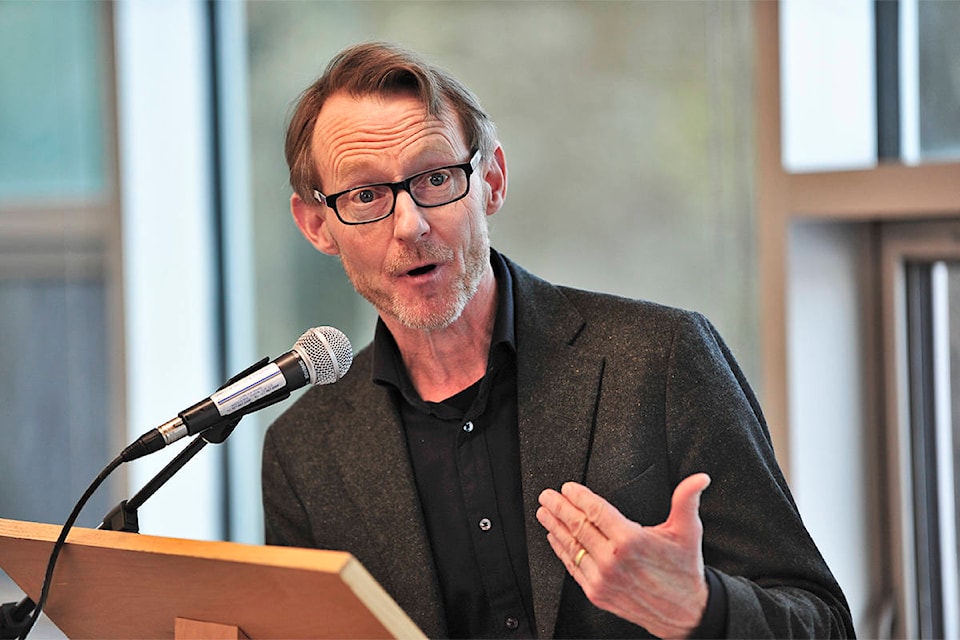Yukon’s Chief Medical Officer Brendan Hanley called YG’s opioid plan that was released this week a “progress report,” one that doesn’t explicitly set benchmarks to mitigate the crisis.
“I would say no, because I feel we’re still in acute mode and crisis mode,” he said. “I guess there’s one benchmark we’re looking for is that we have no opioid-related deaths, and we’re still, as you know, seeing opioid-related deaths. As long as we’re seeing deaths, we’re seeing failures.”
The Department of Health and Social Services’ “Opioid Action Plan” ropes together what’s been done to mitigate overdoses since April 2016 — when the first death was announced by the coroner’s office — and what it proposes to do in the next couple years.
“We’ve had this plan in draft for a year,” Hanley said, “and that’s what we’ve been working off.”
Connected to the crisis, Hanley said in an interview on Nov. 15, is that there’s a lack of baseline numbers showing the extent of opioid use in the territory.
Things that YG has already done include distributing more than 1,900 naloxone kits throughout the Yukon and “consolidating the methadone program with some other substance use services in the Referred Care Clinic Yukon in Whitehorse,” the plan says.
Forecasted initiatives to help remedy the problem include, for the first time, Hanley confirmed, creating access in rural Yukon to treatment services like methadone.
“We are working right now on how do we get clients in rural Yukon … who have opioid needs and may either have to go without or live in Whitehorse to access methadone or Suboxone. I’d say that’s a pretty major focus we want to work out in the next year or so.”
Alternative pain treatment is another area that’s said to be looked into.
Non-pharmacological or non-opioid treatments are methods pitched to prevent residents from getting hooked on a drug then entering the throes of more serious addictions later on.
“It’s in the umbrella of what I would call opioid stewardship,” Hanley said. “There’s no doubt, opioids have their place, because they’re highly effective in acute pain management.”
Opioid stewardship means determining whether opioids are the best choice for a particular patient and their pain, he said — if that patient grapples with dependency issues, for instance.
Non-opioid drugs could be anti-inflammatory treatments or antidepressants, Hanley said.
The other effort is to refrain from using chemical drugs to medicate pain altogether.
“Mental health and psychological support,” Hanley said when asked for examples, or pain-relieving modalities like physical therapy and meditation.
Prescription practices is another topic to be tackled, by way of increased education for primary care givers, implementing updated clinic guidelines and “a screening protocol for substance use that is consistent across” health service providers, the plan says.
Also included in the plan is to “assess” expanding drug checking services, lik the federal exemption secured for Blood Ties Four Directions.
How or when this will occur specifically is unclear.
“Assessing isn’t doing. Assessing is taking a look and saying should we do this somewhere else,” said NDP House Leader Kate White, who’s repeatedly raised the opioid crisis on the floor of the legislature this sitting.
The plan, she said, “says all the right things, but it’s really vague.”
“There’s no benchmark or timelines. It doesn’t talk about how we’re reaching people where they are or how we’re gonna do that.”
Further, the plan says nothing about the risks associated with buying hard drugs off local dealers that may contain fentanyl, White added.
“It doesn’t go far enough,” she said. “To me, it feels like we’re missing the point.”
As previously reported by the News, the federal government has agreed to eventually contribute $500,000 for preventative and treatment programs in the Yukon.
The News reached out to Yukon Health and Social Services spokesperson Patricia Living asking how much money the Yukon government has provided to quell the opioid crisis so far. She did not respond.
There have been 16 opioid-related deaths in the territory since 2016. Fentanyl is associated with 12 of those deaths; of those 12, two died in 2018.
Chief Coroner Heather Jones has told the News that, on a per capita basis, the Yukon ranks third across the country as having the most opioid-related deaths — first is British Columbia, followed by Alberta.
Contact Julien Gignac at julien.gignac@yukon-news.com
